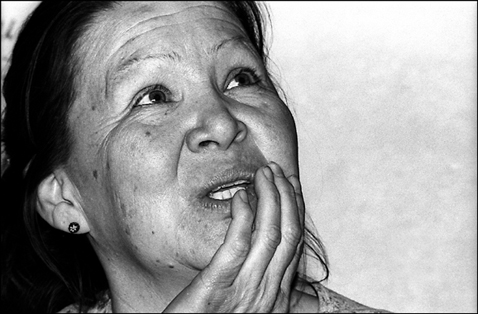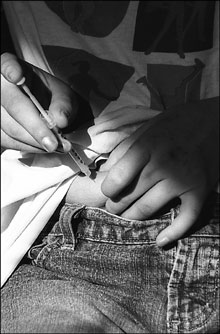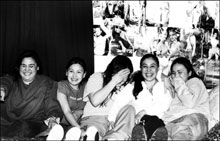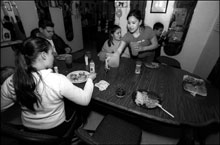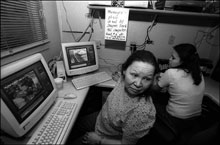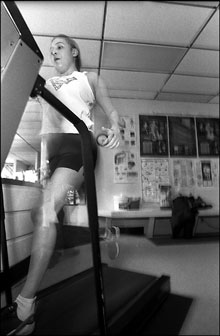Sammy
Ray Dupree stopped giving herself insulin shots at school after
a classmate accused her of shooting up crank.
Like two others in her family, 14-year-old Sammy is an insulin-dependent
diabetic and must inject herself with insulin twice a day. That
means giving herself a shot between classes at the junior high
school she attends in Poplar on the Fort Peck Reservation in
northeastern Montana.
Sammy has permission from teachers to give herself insulin in
the relative privacy of a bathroom stall, but in Poplar, which
has a severe problem with methamphetamine use, hypodermic needles
have a bad connotation.
So when Sammy’s classmate saw her capping a needle as
she walked out of a stall, the girl assumed the worst. Sammy
is sensitive about her condition to begin with, and after being
falsely accused, she’d had enough.
"Ever since then," Sammy says, "I never did it
at school anymore. I just wait until I get home."
Sammy and her family are struggling to live with Type I diabetes,
a form of the disease uncommon in American Indians. Type II,
which usually develops first in adulthood, is epidemic among
Indians, affecting more than 12 percent, twice the rate of occurrence
in the white population. The incidence at Fort Peck mirrors
the national rate at 12 percent.
Sammy, a sister and her father all live with this life-threatening
disease. It’s been both a physical and emotional struggle,
made even more difficult when the girls’ mother contracted
cancer, which is the second leading cause of death in American
Indian women.
American Indian families are hard hit by disease. Indians in
Montana have a life expectancy of 10 years less than white Americans
nationwide. And the federal government spends half as much per
tribal member as it does for health programs for other Americans.
However, in many Indian families, like the Duprees, while health
concerns are pressing, the ways in which they cope are complicated.
Sammy says she hates living with her diabetes, hates the way
it makes her different from her classmates, and hates talking
about it.
The youngest of five sisters, she shares the illness with her
19-year-old sister Rosebud and her 51-year-old father Raymond
Dupree. All three have Type I diabetes, which means their bodies
produce no insulin.
Insulin is a protein made by the pancreas that allows sugar
from the bloodstream to be transferred to the cells for use
as energy. For Type I diabetics, in order to keep blood sugar
from getting too high—a condition that can lead to a coma
and eventually death if not treated—insulin must be injected
into the bloodstream.
Type I used to be called juvenile-onset diabetes since it usually
appears during adolescence. Rosebud developed diabetes when
she was 6. Her mother, Gail Charbonneau, remembers Rosebud asking
one night for glass after glass of tea with sugar. Gail didn’t
know at the time that excessive thirst, along with frequent
urination, are warning signs of diabetes.
Yet while she didn’t recognize the symptoms of diabetes,
Gail certainly knew the treatment, having learned to give insulin
shots to her grandmother when she was 14, as well as living
with a diabetic husband.
When Rosebud first became sick, Gail carried her into the emergency
room at the Poplar hospital at 2 a.m., but the clerk at the
front desk didn’t understand the seriousness of her condition
and told Gail to come back at 8 a.m. Realizing that her child
was in danger, Gail ignored the clerk and stormed past her to
the doctor on duty. The physician took one look at Rosebud and
tested her blood sugar. Normal blood sugar content is from 70
to 120 milligrams per deciliter. Rosebud’s level was 907.
It wasn’t long before she lapsed into a coma and had to
be flown to Billings for treatment. She survived, but from that
point on, she and her family were saddled with the lifelong
responsibility of caring for a diabetic.
Diabetes can kill, but it can also be controlled by insulin,
diet and exercise. However, what Gail Charbonneau faced five
years ago was not so easily conquered.
Gail was diagnosed with breast cancer and because of the severity
of her condition she needed experimental treatment the Indian
Health Service would not cover.
Doctors warned that Gail would die without the stem-cell treatment,
but the $80,000 price was far beyond the family’s reach.
They searched for programs or grants that might provide the
money Gail would need to have a shot at survival.
Even as she grew sicker, Gail tried everything to earn the money.
One day as she dug echinacea roots to sell, her sister came
running to tell her that her mother, Myrna Charbonneau, had
found a way.
After hearing pleadings from Myrna, the family says a doctor
at the Indian Health Service in Washington, D.C., was able to
redirect money set aside in a disaster fund to pay for Gail’s
treatment.
"I was just happy, because this thing was hanging over
my head and if I didn’t have it, you know, I was gonna
die and what’d happen to my girls?" Gail says. "That
was the best thing I ever heard."
Within 24 hours, Gail and Myrna were on their way to Billings
for the treatment Gail needed. But her stay would be long and
the treatment difficult so Gail sent her daughters to live with
their eldest sister in California, splitting up the family.
Myrna, a nurse, knew Gail would need her by her side, so she
went along though it meant giving up her job.
Again, money seemed a barrier. Faced with no income and setting
up a second household 300 miles from home, again Myrna found
a way. She sold her mineral rights on land that she owned at
Fort Peck, land that had been deeded to her family during the
allotment of the reservation.
Gail and Myrna moved to Billings to begin the treatment. But
paperwork from the Indian Health Service didn’t arrive
so they spent the first month waiting.
At Christmas, Gail’s daughters came to visit, but her
doctor warned that she shouldn’t leave the hospital.
She remembers his words exactly: "He said, ‘You know,
you’re a walking dead woman,’ because I had no immune
system."
But Gail went anyway and while she was with them, she sneezed,
and her nose started bleeding and wouldn’t stop. Her family
rushed her back to the hospital and she was given pills to help
her blood clot.
Even with all that, Gail says the most difficult part of her
treatment, which lasted a year, was being away from her family.
Eager to get back to Poplar, she was relieved to hear that some
final stages of her treatment could be completed on the reservation.
So she moved home, then found it wasn’t so. They returned
to Billings and completed the regimen and then went back again
to Poplar where she could resume taking care of her children.
After spending her life caring for others, cancer had forced
Gail to care for herself. But she’s now been cancer-free
for three years and has gone back worrying about the other potentially
deadly disease that affects her family.
Just as Gail now understands intimately the physical havoc cancer
can wreak, she knew already the damage diabetes can do. She
and her sisters watched their grandmother suffer from the disease.
Gail’s sister Jeannette Charbonneau lived with her grandmother
for a time and remembers the way diabetes slowly ate away at
her body.
"They cut first her foot off, then this part off,"
Jeannette says as she points to her calf. "Then she got
this other one (foot) cut off. And she lost her sight, and after
she lost her sight she just decided to kind of give up. She
wouldn’t eat. After two weeks, she starved. She said she
had a long life. She was 89."
Diabetes is a full-time disease that cannot be ignored.
Pauline Boxer works for Fort Peck Diabetes Outreach and after
having watched her own mother die from the disease, and then
getting it herself, she has devoted her life to educating other
Indians how to live with it. She says she knew the disease only
as a name growing up, but never thought about its implications
or that she might someday get it.
"When I found out I was a diabetic, it about blew my mind,"
she says. "I said ‘I don’t want to be a diabetic,’
because I seen what my mother went through. My mother was a
Type II diabetic; she ended up on dialysis, she ended up getting
her fingers chopped off, she went blind, she lost her hearing,
and then she just had a heart attack. I don’t want to
see anybody go through that."
Pauline knows many people are in denial about diabetes but she
knows too well the consequences.
"I look around and I see people younger than I am that
are completely blind because they don’t want to do anything
with their diabetes," Pauline says. "They
don’t want to take any kind of education. They don’t
want to commit to the program and listen to the nutritionist.
They don’t want to come in and see the foot doctor. They
don’t want to get their eyes checked. They think they
have diabetes and nothing else is gonna happen to them. But
that’s not true. People are losing their limbs because
of diabetes, people are going blind because of diabetes. People
are having heart attacks, people are ending up on dialysis.
It’s a sad thing to see most of our Indian people with
diabetes."
Although the Dupree family deals with the less common Type I
diabetes, the health risks are still formidable.
Raymond, 51, was told five years ago he would be blind within
a year, but has managed to keep his vision so far.
Rosebud, now 19, has gone into a high-blood-sugar-induced coma
more times than Gail cares to count and has already been referred
for dialysis treatment, though she has managed to avoid it by
taking better care of herself. If diabetics let their blood
sugar fluctuate too much, it can eventually lead to kidney failure.
Dialysis cleans a person’s blood of toxins when their
kidneys begin to fail.
Rosebud sounds resigned to the probable progression of her disease
and eventual dialysis.
"If I need it, I’ll probably just go ahead and do
it," Rosebud says, but also says she accepts what might
eventually happen.
"I’m just not afraid of dying," she says.
Rosebud is also on a list to receive a pancreas transplant.
The pancreas produces insulin and is usually transplanted in
concert with a kidney. But because of the powerful immunosuppressant
drugs a person must take to keep the body from attacking the
foreign organ, 15 percent of patients who receive a new pancreas
die within five years.
Jeannette says Rosebud’s outlook changed after she came
out of one of her more recent comas and that since then she
has been taking better care of herself.
"Rosebud came out of that coma different," Jeannette
says. "Her whole perspective was more positive."
But Gail and her sister Jeannette are pleased with what they
see as progress on some fronts, but still worry about Rosebud,
who has been living by herself for four months.
"She’s got her phone shut off now," Gail says.
"God, if somebody doesn’t hear her, you know? What
if one of these days we go over there, she’s in a coma?
I just want to move her back to the house; I’m not comfortable."
And even if Rosebud is better, Gail thinks she has a way to
go before she is doing all she must to get healthy.
"She won’t even go over there (to the hospital) by
herself," Gail says. "She’s still like a child.
She’ll come over to the house and sit there, ‘Mom,
I’m sick.’ I say ‘You want to go the hospital?’
She goes, ‘Yeah.’ She won’t go over there
by herself, so she waits around for me to take her. She gets
dehydrated. She was wearing a size 9 pant, and she’s down
to like a 5 now. It just takes a toll on her. She’s still
sickly right now."
Both Rosebud and Sammy say Raymond was a poor role model with
his denial of his disease.
"Probably where I learned to be ashamed of my diabetes
is from my dad," Sammy says. "He don’t talk
about it at all."
Gail agrees.
"It probably comes from their dad," she says. "You
know when I first met him, I heard he was diabetic, but I’d
never really seen any of his medicine until 8 months later when
he got sick. He’s done insulin shots since he was 15.
I mean he kept it from me, he wouldn’t even tell me he
was diabetic. I knew he was. He’s real private. He won’t
tell anybody and if he got sick, he just got sick."
Raymond declined to speak about his illness for this story.
Gail says after Raymond developed diabetes when he was 15 years
old, he would have to walk to the government health clinic every
day to get his insulin shot. He has hated going to clinics ever
since.
"He still to this day won’t go up and get his own
medicine," Gail says.
Gail says Raymond’s fear of getting help and his denial
of the disease have had their effect on Rosebud and Sammy. She
says because Raymond doesn’t always eat enough, he frequently
goes into seizures from low blood sugar and has to be held down
to have Kool-Aid poured in his mouth.
"It scars the girls the most seeing their dad like that,"
Gail says. "They never want to be like that."
Rosebud says if she has children, she hopes things will be different,
but isn’t sure they will be.
"I wouldn’t want my kids to go through the same things
I went through," she says. "I’d probably try
to talk to them, but I don’t know until that time comes."
Sammy still struggles to come to terms with her illness.
"I don’t like it at all," Sammy says. "I
hate living with it. It really sucks."
And Gail, dealing with two daughters and a husband with diabetes,
just tries to take it as it comes.
"You have to deal with it one day at a time," Gail
says. "Living by the needle isn’t easy."
back
to top...
|
|
|
| Rosebud
Dupree injects her belly with one of the two daily doses
of insulin that her body requires to function. When Rosebud
was first diagnosed at the tender age of 6, her older
sisters had to learn how to give the injection. Now, says
Rosebud, she's even taught some of her close friends how
to give the shot. |
|
| The
Dupree sisters, from left, Raylene, Sammi Ray, Shyann,
Billie Ray and Rosebud gather for a photo opportunity
in the youngest, Sammi Ray's room. The girls got the giggles
after Raylene squeezed on to the side of the bed, breaking
the springs and collapsing the backside of Sammi's new
bed. Despite the suprise, the five seemed happy just to
be together. |
|
|
Family
members, from left, Billie Ray, Brenden, Rosebud, Sammi
Ray and Brady, gather around their mother's table for
dinner. Even though Sammi Ray is the only child still
living with Gail Charboneau, Gail's home is always filled
with family. Billy Ray says it's a place where the Dupree
children can get together to visit and resolve problems
they have. |
|
|
Gail
Charboneau peers out of the tiny Tribal Express office
where she and her daughter Rosebud work. Gail is the manager
of three gas stations along Montana's Hi-line. Her sister
Jeanette says Gail continued to work even through her
battle with cancer and often works double shifts. Gail
says she just appreciates the chance to keep a close eye
on her daughter. |
|
| Determined,
strong-willed and energ-etic, Billie Ray Dupree works
out daily to care for her body and keep it fit, in light
of her genetic disposition toward developing diabetes. |
|
